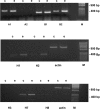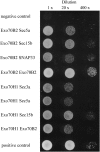The role for the exocyst complex subunits Exo70B2 and Exo70H1 in the plant-pathogen interaction
- PMID: 21199889
- PMCID: PMC3060688
- DOI: 10.1093/jxb/erq402
The role for the exocyst complex subunits Exo70B2 and Exo70H1 in the plant-pathogen interaction
Abstract
Recently, the octameric vesicle-tethering complex exocyst was found in plants and its importance for Arabidopsis morphogenesis was demonstrated. Exo70 exocyst subunits in plants, unlike in yeasts and mammals, are represented by a multigene family, comprising 23 members in Arabidopsis. For Exo70B2 and Exo70H1 paralogues, transcriptional up-regulation was confirmed on treatment with an elicitor peptide, elf18, derived from the bacterial elongation factor. Their ability to participate in the exocyst complex formation was inferred by the interaction of both the Exo70s with several other exocyst subunits using the yeast two-hybrid system. Arabidopsis plants mutated in these two genes were used to analyse their local reaction upon inoculation with Pseudomonas syringae pv. maculicola and the fungal pathogen Blumeria graminis f. sp. hordei. The Pseudomonas sensitivity test revealed enhanced susceptibility for the two exo70B2 and one H1 mutant lines. After Blumeria inoculation, an increase in the proportion of abnormal papilla formation, with an unusual wide halo made of vesicle-like structures, was found in exo70B2 mutants. Intracellular localization of both Exo70 proteins was studied following a GFP fusion assay and Agrobacterium-mediated transient expression of the constructs in Nicotiana benthamiana leaf epidermis. GFP-Exo70H1 localizes in the vesicle-like structures, while GFP-Exo70B2 is localized mainly in the cytoplasm. It is concluded that both Exo70B2 and Exo70H1 are involved in the response to pathogens, with Exo70B2 having a more important role in cell wall apposition formation related to plant defence.
Figures







References
-
- Aist JR. Papillae and related wound plugs of plant cells. Annual Review of Phytopathology. 1976;14:145–163.
Publication types
MeSH terms
Substances
LinkOut - more resources
Full Text Sources
Molecular Biology Databases
Research Materials

